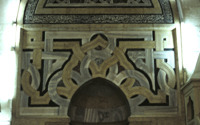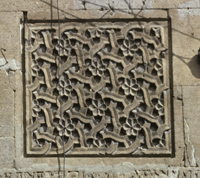Chirality is the property of lacking symmetry of reflection. A figure or pattern has chirality if it cannot be “superimposed” on a mirror image of itself.1 Essentially, all figures and patterns that have an isometry of reflection are not chiral, and all figures and patterns that lack an isometry of reflection are chiral: they are asymmetrical in a certain way.
Colloquially, chiral figures and patterns have handedness (the Greek root of the word “chiral” means “hand”). Spirals such as DNA and RNA, corkscrews, and yarn, with its S- and Z-twists, have handedness: no matter how you turn a corkscrew it still spirals in the same direction (left- or right-handed); only when it is reflected does its handedness change.
For Islamic art I think chirality is most interesting in connection with interlacings, in which elements of a design cross over each other in consistent ways. Mathematics deals with such interlacings in knot theory, a branch of topology. If I understand correctly, a mathematical knot is a strand forming a circle (unlike a real-world knot, its ends are joined); the strand may be twisted around itself like a real-world knot. Knots interlaced with each other are called links.
These interlacings are a subject for another article. This appendix is meant only to suggest how chirality affects the perception of the symmetry of designs.

Figure 1. Aleppo, Madrasah al-Firdaus, upper part of mihrab.
There are patterns that can have the property of appearing to have symmetries that they do not have because of their intertwining construction. The mihrab revetment of the Madrasah al-Firdaus in Aleppo, of 633/1235–362 appears to have symmetry of reflection, but actually has no symmetry at all because of its chiral nature.
One might say that this kind of composition has “symmetry negated by chirality”. Of course one can overlook the chirality and see symmetry of reflection anyway, another example of seeing things more than one way.

Figure 2. Aleppo, Masjid Bāb al-Aḥmar, 1480, facade detail (photomanipulated to reduce foreshortening). 3
The above decorative panel from one of the facades of the Masjid Bāb al-Aḥmar in Aleppo is an example of a chiral pattern that has symmetries other than symmetry of reflection. I manipulated the image to correct the foreshortening effect of photographing it from below, making it nearly square, and I believe I overdid the correction. In fact the design seems to be somewhat wider than it is tall,4 and whereas in my manipulated version the rosettes lie at the angles of a series of overlapping (nearly) regular hexagons, defining a lattice the points of which are equidistant, the lattice of the real design seems to be somewhat compressed vertically. If so, the real design does not have the (sixfold) symmetry of rotation I credit it with here. For the effect of compression see Appendix G.
This design as I have rendered it has symmetry of rotation (every 60° turn produces a symmetrical transformation) and symmetry of translation, but while at first it seems to have symmetry of reflection in fact it does not (nor does it have symmetry of glide reflection). In Washburn and Crowe's notation, it is classified as p6.5 Here chirality does not negate symmetry; rather, this example illustrates nicely the disjunction between patterns with symmetry of reflection and those without (chiral patterns).
Specifying symmetries by using Washburn and Crowe's notation does not describe the characteristics of a pattern's chirality, for which taxonomies and notations must be sought in knot theory.
Patterns, then, can have apparently comprehensible symmetries that are negated by their interlacings. Understanding the artistic effect of the symmetries of such patterns may require two levels of analysis: both considering their chirality and generalizing beyond it. At the first level, the mihrab of the Madrasah al-Firdaus is not symmetrical; at the second, which reflects a way in which the viewer experiences it, it has symmetry of reflection (and the mind adds, “with a twist!”). In the case of the panel from the Masjid Bāb al-Aḥmar the interlacing does not destroy symmetry entirely, but rather only reduces it (“symmetry reduced by chirality”?).
1. Oxford English Dictionary, 2nd ed., Oxford, 1989, citing William Thomson (Lord Kelvin), 1894: “I call any geometrical figure, or group of points, chiral and say that it has chirality, if its image in a plane mirror, ideally realized, cannot be brought to coincide with itself.”
2. Terry Allen, Ayyubid Architecture (electronic publication), Occidental, Calif., 2003, ch. 8, s.v.
3. Heinz Gaube and Eugen Wirth, Aleppo: Historische und geographische Beiträge zur baulichen Gestaltung, zur sozialen Organisation und zur wirtschaftlichen Dynamik einer vorderasiatischen Fernhandelsmetropole (Beihefte zum Tübinger Atlas des vorderen Orients, no. 58), 2 v., Wiesbaden, 1984, no. 332, p. 381.
4. Compare the photograph in Michael Meinecke, Die mamlukische Architektur in Ägypten und Syrien (648/1250 bis 923/1517), 2 v. (D.A.I., Kairo, Abhandlungen, Islamische Reihe, v. 5), 1992, v. 1, pl. 64 d.
5. My path through the flow chart:
P. 128, “What is the smallest rotation?” 60°
“Is there a reflection?” No.
In the real design, which is compressed vertically, the smallest rotation is 180° and the answer works out to p2; if there were no interlacing it would be p6m.